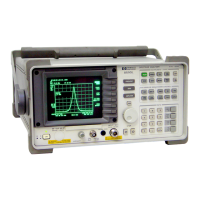566 Chapter11
Synthesizer Section
Unlocked Fractional N PLL
9. Divider and integrator troubleshooting: Measure the frequency of
the pulses at TP6 in block AO. Look up the expected problem area in
Table 11-11 on page 566 and go to the appropriate troubleshooting
steps.
10.Divider troubleshooting:
a. Check the frequency at A14TP2. It should be equal to the
frequency at A14TP1 divided by two.
b. The signal at A14TP3 should be greater than −14 dBm.
c. Use an analog oscilloscope to view the signal at A14TP5. Adjust
the scope triggering to view the divide-by-16 signal. The
frequency at this point will be varying as the prescaler changes
its divide number to either 16, 17, 20, or 21. The prescaler uses 16
as the divide number most frequently. The frequency displayed on
the oscilloscope should equal the frequency from TP2 divided by
16.
d. Use an oscilloscope to view the signal at pin 8 of U112. Its
average frequency should be given by:
f = f(A14TP5) × 80 MHz/RAW OSC FREQ
where: f(A14TP5) is the frequency measured at TP5, and RAW
OSC FREQ comes from step 4 (A14TP1).
If the frequency is in error, the fractional divider, block AS, is not
functioning. Check that FRAC N RUN on U113 pin 39 is high.
e. Use an oscilloscope to verify that the signals at N_in (U112 pin 8)
and N_out (TP6) are identical except for a sub-microsecond delay.
Detector and integrator troubleshooting: Check the phase detector
output on TP11 in block AO. If F_ref is higher in frequency than TP6
(reclocked VCO/N), then the average voltage at TP11 should be
positive by 0.05 V to 10 V. If F_ref is lower, TP11 should be −0.05 V to
−10 V.
Table 11-11 Divider and Integrator Troubleshooting
Measured
VCO
Frequency
Relative to
Expected
Value
TP6 Frequency
zero <2.5 MHz 2.5 MHz >2.5 MHz
Measured >
expected
Dividers Dividers Dividers Detector or
integrator
Measured <
expected
Both Detector or
integrator
Dividers Dividers

